replication of DNA viruses II
1/31
this lesson about rest of DS viruses:
- - normal DS DNA
- - DS DNA that go thru retroviral stage
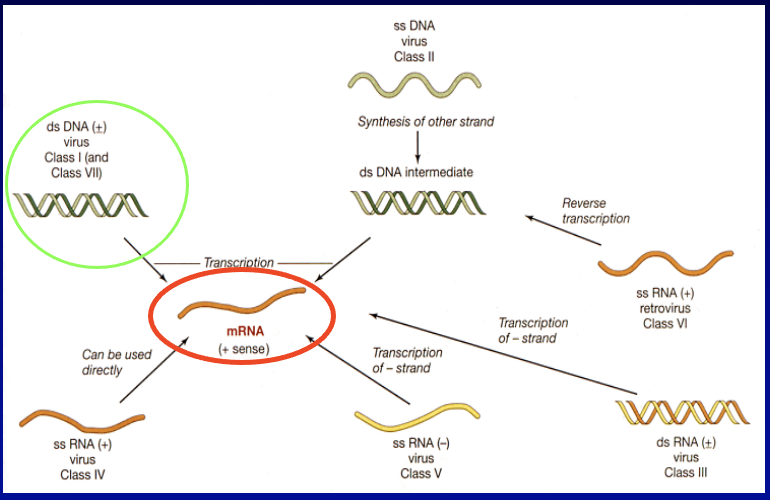
double stranded DNA viruses
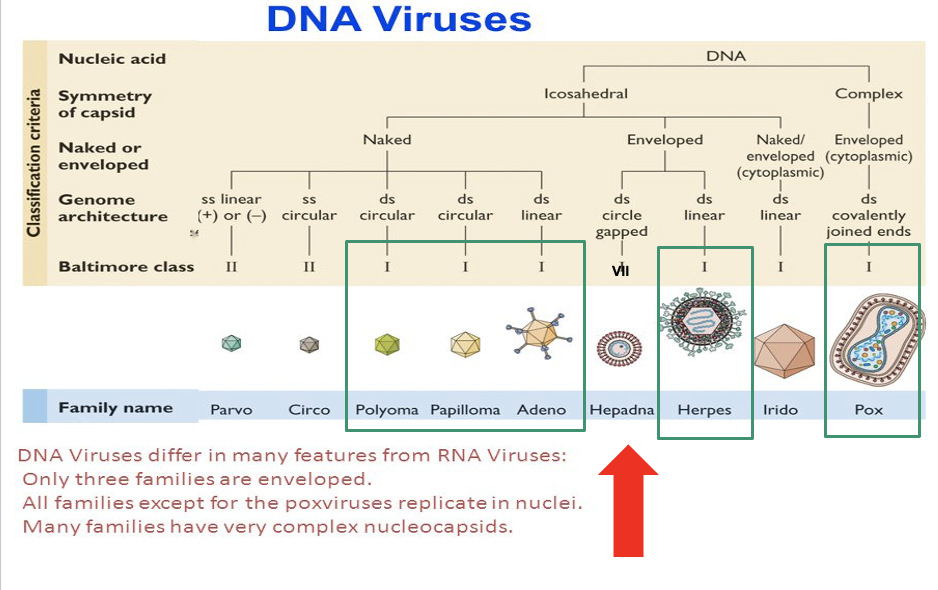
- double stranded
- double stranded with RNA activity
3 families of DNA viruses are enveloped
- herpes, Pox, hepadna viruses
Pox viruses don’t need to replicate in nuclei
- they are independent bc have machinery they need to replicate
class I: double stranded DNA
subdivided into 2 groups:
-
replication is exclusively nuclear
- replication of these viruses is dependent on cellular factors
-
replication occurs in cytoplasm
- these viruses evolved / acquired all factors for transc./replication of genomes and are largely independent of the cellular replication machinery
double stranded DNA virus replication
diverse/more complicated replication mechanisms than RNA viruses
some require host pol, some encode their own replication factors
dsDNA viruses make use of several mechanisms to replicate their genome
- bidirectional replication
- rolling circle mechanism
- strand displacement
DS DNA bidirectional replication
(GO OVER THIS)
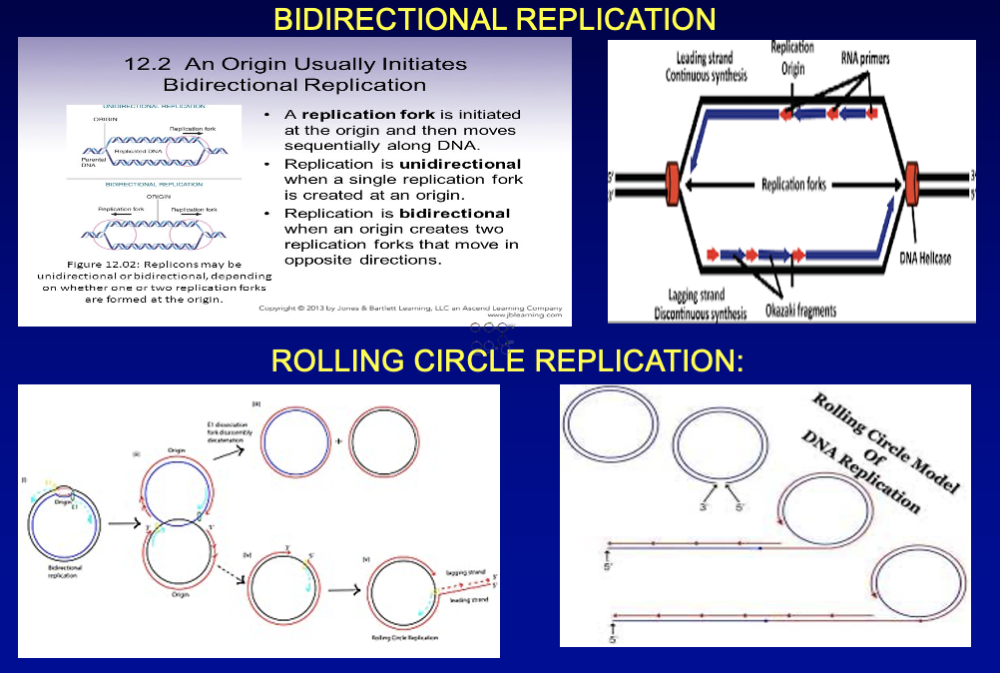
bidirectional replication
- 2 replication forks established at replication origin site + move directions opposite of each other
DS DNA rolling circle mechanism
(GO OVER THIS)
produces linear strands while progressing in a loop around circular genome
DS DNA strand displacement
(GO OVER THIS)
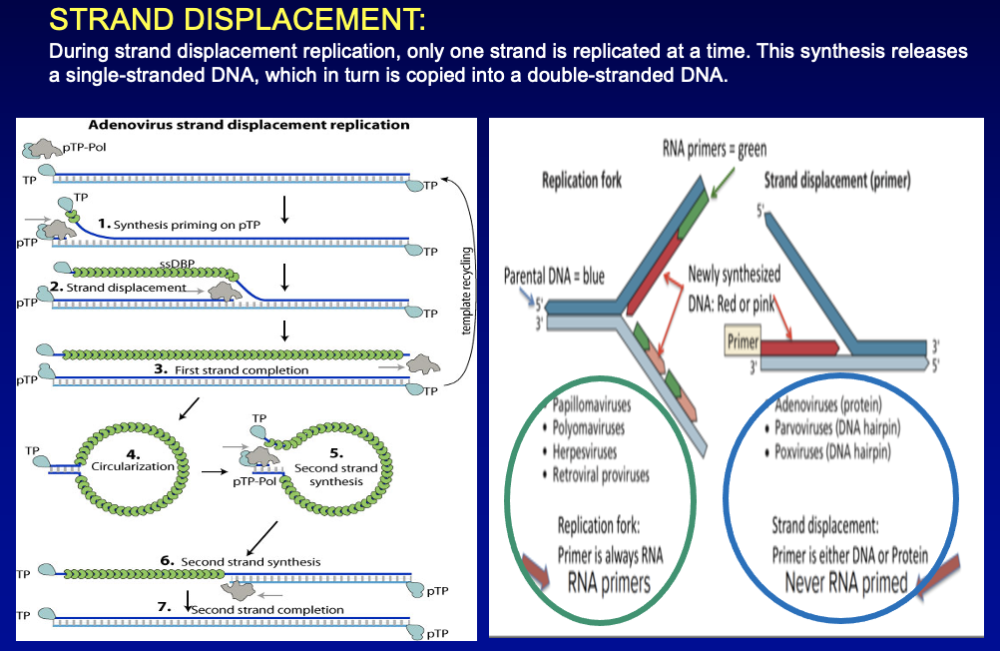
method where one strand is made from template strand, complimentary strand is made from prior synth. strand
= dsDNA genome
During strand displacement replication, only one strand is replicated at a time. This synthesis releases a single-stranded DNA, which in turn is copied into a double-stranded DNA.
DS DNA viruses transcription
3 step process to make mRNA
-
transcription preinitiation complex
- binds to DNA upstream of site where transc. begins -> allows recruitment of host RNA polymerase (RNA pol can be from self or from host, depending on if the virus has its own things needed to replicate)
- use negative srand (non coding strand) as template for synth. mRNA strands
- RNA pol terminates transcription upon reaching stop signal
ds DNA cviruses
Ds DNA virus does 2 things with its genes
- make mRNA -> translated in ribosomes of infected cell (NO viruses have their own ribosomes for translation)
- replicates its ds genome – make copies
what ribosomes must ALWAYS be used for translation?
HOST CELL RIBOSOMES
viruses NEVER have their own ribosomes
DS DNA viruses subdivided into 5 families
- polyomaviridae
- papillomaviridae
- adenoviridae
- herpesviridae
- poxviridae
infect mammals and us
polyomaviruses
- small
- nonenveloped
- circular DS DNA
- widespread in nature
-
latent in healthy hosts after primary infection
- illness occur in immunocompromised ppl
- Immunocompetent healthy host-> viruses may internalize + be latent - we are exposed to them - whether we get sick or not depends on our immune strength
- ex: human
polyomaviruses BKV and JCV cause hemorrhagic cystitis and
progressive multifocalleukoencephalopathy
- In ppl recipients of organs, they are subjected to immunosuppressed states, and these viruses can make them sick bc of lowered immune system
- ex: merkel cell polyomavirus may cause merkel cell carcinoma
- ex: SV40 can cause tumors, usually is latent though if healthy
papillomaviruses
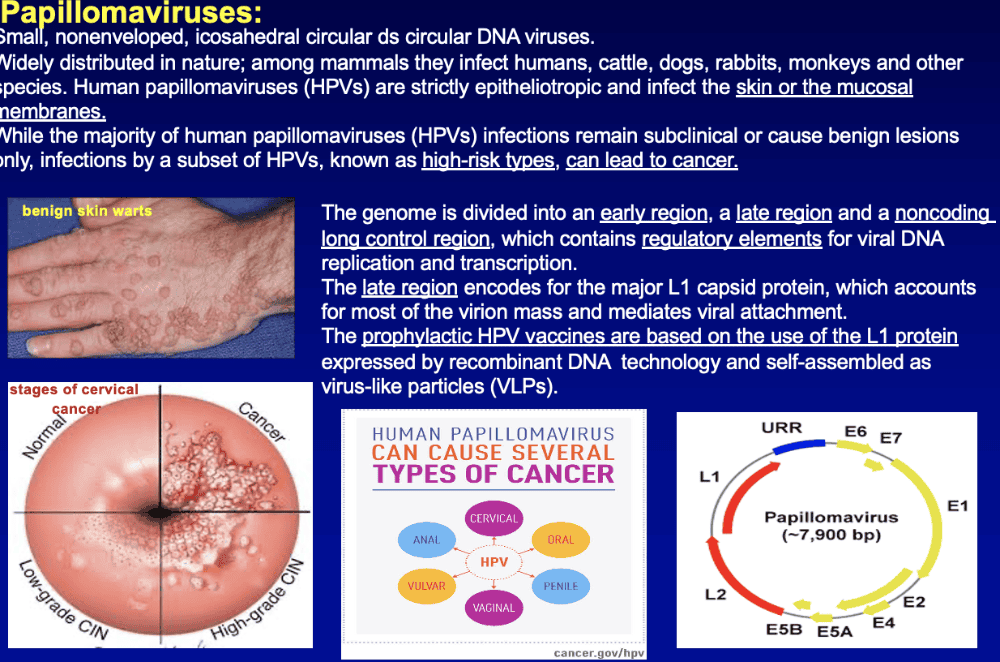
- small
- nonenveloped
- icosahedral circular DS DNA
- infect humans, cattle, dogs, rabbits, monkeys, and some more.
- ex: HPV (human papillomaviruses) infections are usually
subclinical or can cause benign lesions
- but infections by high risk types can lead to cancer
- genome:
- early region
- code for transforming proteins that mediate oncogenic properties of the high risk HPVs (E6/E7 genes)
- late
region
- encodes for major L1 capsid protein -> accounts for most of virion mass + mediates viral attachment (what vaccines are based on)
- noncoding
long control region
- has regulatory elements for viral DNA repl./transc.
- early region
mechanism by which cellular transformation of E6/E7 genes of high risk HPV work?
E6 protein complexes with tumor suppressor protein P53 and targets it for destruction
E7 complex w/ tumor suppressor protein (Rb) -> regulates expression of genes that activate cell cycle
(normally p53 and Rb inhibit cellular proliferation)
- E6 protein made by HPV inhibits function of p53
- E7 protein made by HPV inhibits function of Rb
in HPV infected cels, HPV oncoproteins lead to

continued cell proliferation without time for repair of DNA damage
leads to genetic instability + accumulation of addl. cellular mutations + chromosomal changes
-> thus infections with higher risk HPVs prepare ground for cellular genetic alterations that underlie cervical cancer
HPV proteins lead to cont. cell proliferation
adenoviruses
- medium sized
- nonenveloped (naked)
- icosahedral nucleocapsid
- isolated from human adenoids
- range of
illnesses caused
- ex: mild resp. virus (common cold), conjunctivitis, deadly disease in ppl w/ weakened immune system
- genome
- linear, nonsegmented DS DNA (30-40 genes)
- heavily relies on host cell for survival/replication
- relies on cellular apparatus for transcription, but possesses various mechanisms that regulate viral gene expression
- ex: trans-acting transc. activators like E1A protein, post transc. regulation of expression, etc.
- infection of cells divided into 2 stages (early/late)
gene therapy - adenoviruses
- adenoviruses - popular viral vector for gene therapy due to ability to affect replicating and non replicating cells
- code for proteins w/o integrating into host cell genome
- use as vehicle to administer targeted therapy in form of recombinant DNA/protein
- found to work in monogenic diseases + cancer
Used as vector
Adenoviruses big enough to accommodate transgenes
Use to repair or internalize 1 particular gene that may be missing, mutated, etc.
Used as vehicle to administer targeted therapy
Oncolytic adenoviruses -> lyse the cells as cancer treatment
vaccines - adenoviruses
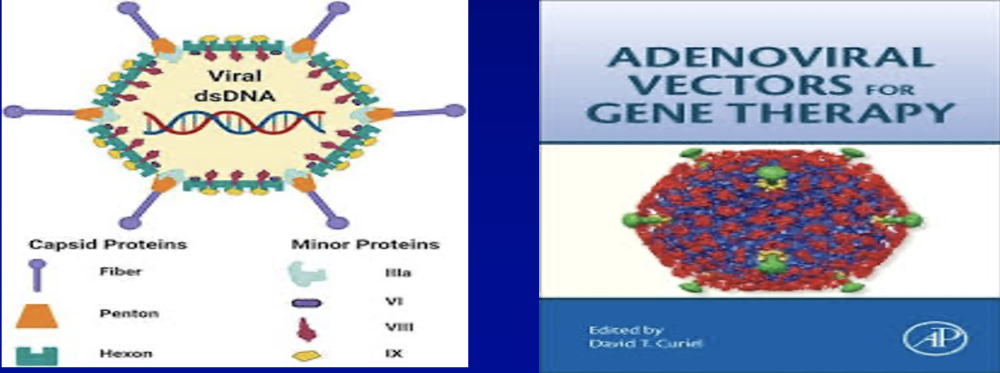
- adenoviruses used to make viral vector COVID-19 vaccines
- Ad5 - vector to transport surface protein gene of SARS-CoV-2
- goal is to genetically express the spike glycoprotein of covid
Vaccines
- some COVID 19 vaccines use adenoviruses as vectors to introduce spike
Adenoviruses good for gene therapy + vaccines
herpesviruses
- enveloped
- large
- DS linear DNA
- 3
groups
- alpha herpesviruses
- type 1
- type 2
- chickenpox virus
- short cycle, induce cytopathology, broad host range
- beta herpesviruses
- cytomegalovirus and human herpesvirus 6/7
- long cycle, restricted host range
-
y herpesviruses
- epstein barr virus and human herpesvirus 8 (kaposi sarcoma virus)
- very restricted host range
- all herpes virus can establish lifelong latent infection w/ specific tissues (characterized for each virus)
- alpha herpesviruses
herpesvirus transc., gene replication, and capsid assembly occur in
host cell nucleus
genes replicated in specific order
- immediate-early genes
- early genes
- late genes
immediate-early genes encode
regulatory proteins
early genes encode
enzymes for replicating viral DNA
late genes encode
structural proteins
how herpesvirus get out of cells and what happens in latent cells
- virion progeny transported to cell membrane via golgi complex + host cells die as mature virions released
- in certain cell types, virus stays in lifelong latent state
- ex: latency of chicken pox (in nerves) -> CAN get shingles when older
- neurons, monocytes, lymphocytes
- latent viral genome may reactivate at any time
transmission of HSV 1 and 2
1 - oral
2 - genital
control of herpesvirus infection
- prevention
- vaccine for chickenpox
- HSV 2 and cytomegalovirus only have passive immunity
- avoid contact when lesions are visible
- treatment
- acyclovir for hsv 1, 2, and chickenpox
- etc, see slide
herpesviruses (80 genes)
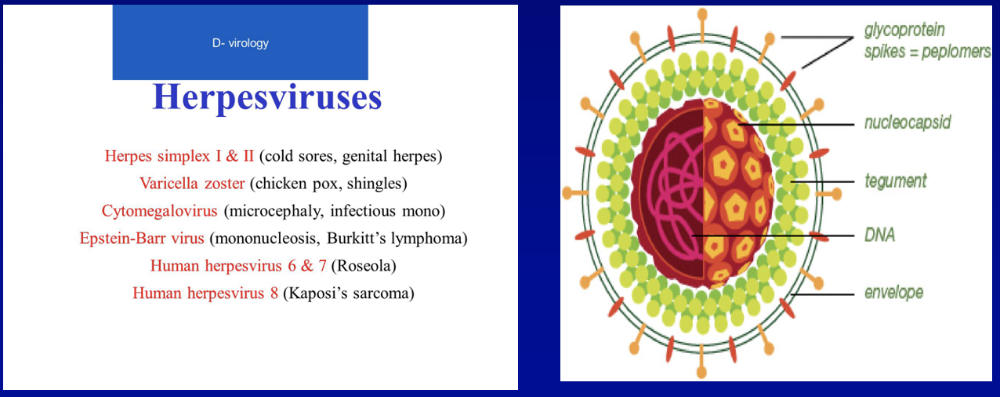
- encode many enzymes of DNA metabolism + trans-acting factors that regulate temporal expression of virus gene, controlling phases of infection
- transcription of the large, complex genome is sequentially regulated in a cascade fashion
Not as independent as poxvirus
Encode enzymes involving DNA metabolism
Expression is regulated
Cytomegalovirus – related to microcephaly, Etc.
herpesvirus gene expression
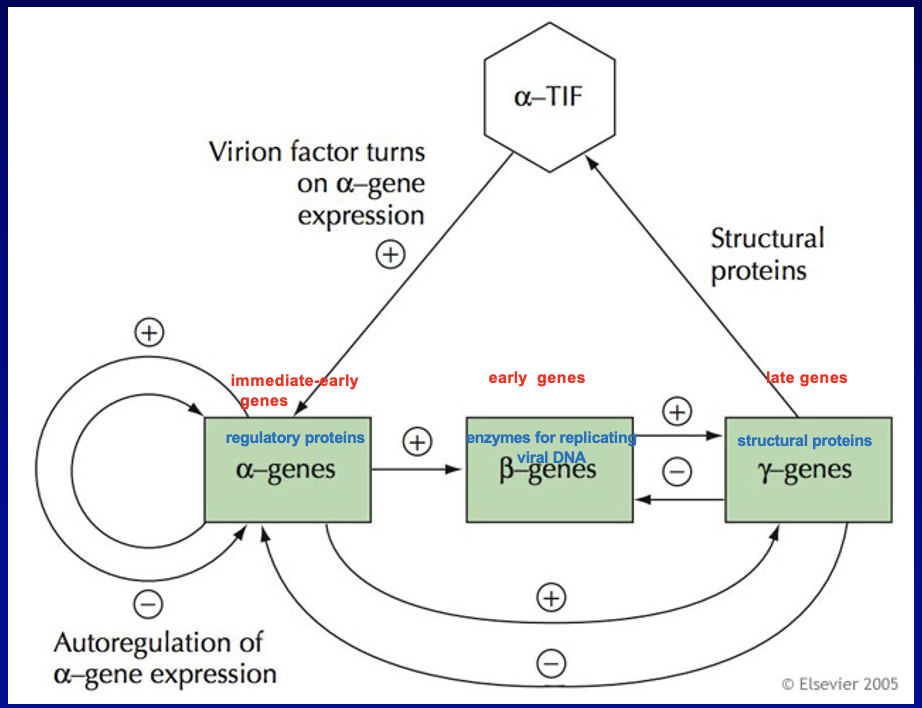
poxvirus
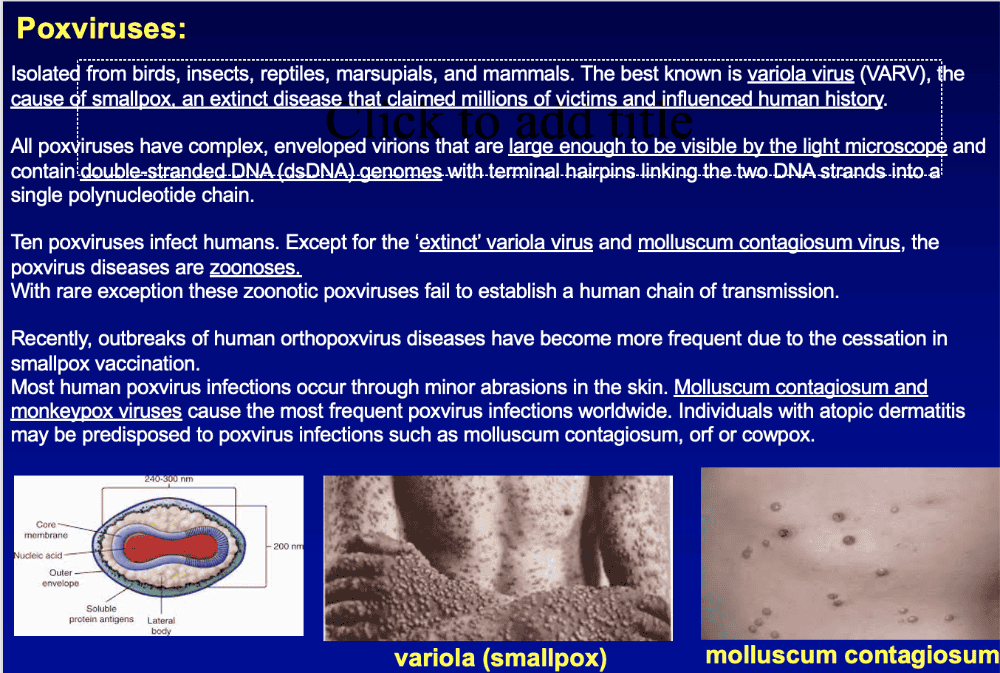
- isolated from birds, insects, reptiles, marsupials, mammals
- complex enveloped virions
- large - visible by light microscopy
- ds DNA genomes
- terminal hairpins linking the 2 DNA strands -> single polynucleotide chain
- ex: variola virus (VARV) - cause smallpox (extinguished w/ vaccines). molluscum contagiosum and monkeypox most frequent in world
- 10 infect ppl
- zoonoses
- minor abrasions of skin
- encode all enzymes needed for RNA and post. transc. modification of mRNAs, and DNA synth.
- replicate in cytoplasm using only host ribosomes
- many enzymes packaged (all it needs) in virus particle -> so replication occur in cytoplasm under viral control
Poxviruses
- best known – variola virus – cause smallpox
- extinguished w/ vaccines
Large – large enough to see on light microscope
DS DNA genome w/ terminal hairpins
10 poxviruses infect humans
Poxviruses – zoonotic (from animals)
Poxvirus outbreaks recently due to cessation of vaccines
- bc they are very similar to each other
unlike other DNA viruses that rely on nucleus, poxviruses replicate entirely
in the cytoplasm of infected cells
poxviruses evade ___ well
innate / adaptive immune responses
using proteins encoded by their large genome
poxvirus gene expression
by virus enzymes associated w/ core of particle + divided into 2 phases
early genes
- 50% of poxvirus genome
- expressed before genome replication
late genes
- expressed after genome replication in the cytoplasm
- but expression is dependent on virus-encoded rather than cellular transcription proteins
poxvirus replication cycle
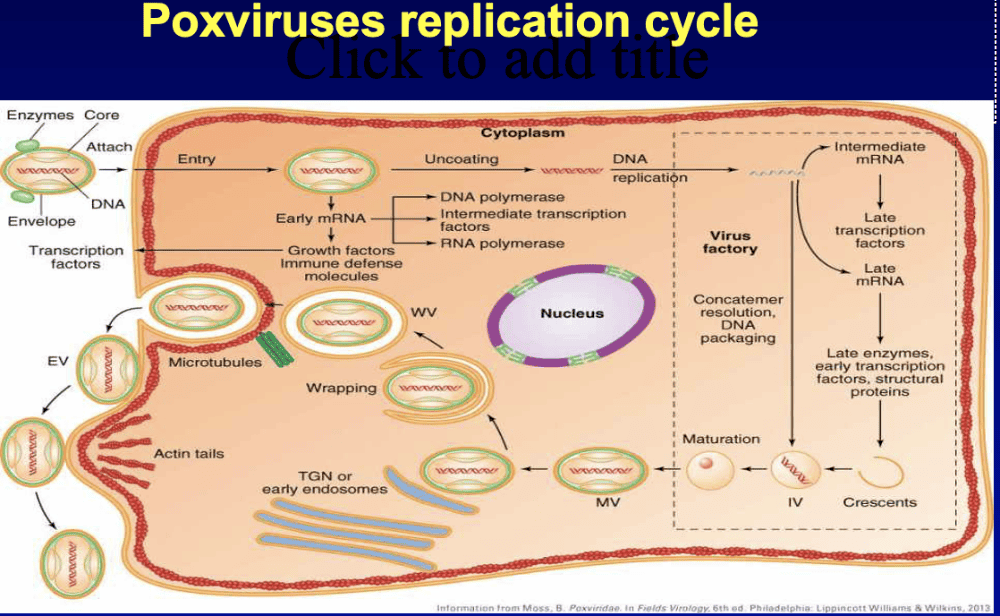
additional effects of DNA viruses: on the cell cycle
-
p53 inhibitors
- SV40 large T (polyoma)
- adenoma E1A
- HPV E6
-
RB inhibitors
- SV40 large T (polyoma)
- Adeno E1B
- HPV E7
Addl effection of DNA viruses
- tumor suppressors – breaks in cell cycle
- viral proteins interact w/ inhibitors
viral effects on host cells
viruses can have one of several diff effects on their cellular hosts
- abortive infections
- cytolytic infections
- persistent infections
abortive infections
virus cannot go in cell (depends on receptor)
if infect cell unable to receive virus -> abortive infection, does nothing to the cell
may result when virus mistakenly infects a cell that does not permit viral replication (tropism)
cytolytic infections
lead to cell lysis and release of large numbers of virus
persistent infections
may be productive, latent, or transforming
- exit thru budding
- can be latent
- can be transforming - oncogenic, transforms the cell
coordinated replication of viral components
- expression of viral regulatory proteins (immediate early genes)
- expression of viral genes involved in replication (early lytic genes)
- replication of viral genome
- expression of late lytic genes (capsid, envelope)
- assembly and egress
DS DNA with RNA intermediate
hepadnaviridae
- hepadnaviruses - group of DNA viruses infect hepatocytes + can cause liver injury and hepatocellular carcinoma (HCC) in mammals/birds
- Hep B (HBV) - cause acute/chronic Hep B, cirrhosis, and HCC in humans
- small
- enveloped
- partially DS DNA (3-3.4 Kb) replicated by reverse transcription of RNA intermediates
-
use
overlapping reading frames (ORF)
- to encode
- envelope
- nucleocapsid proteins
- polymerase w/ domains that having priming, reversetranscriptase, and RNAse H
- to encode
what family of viruses is DS DNA with RNA intermediate?
hepadna viridae
genome:
small genomes of partially DS, partially SS circular DNA
genome = 2 strands
- 1 longer (-) sense (purple)
- 1 shorter (+) strand of variable length (orange)
2 ends of long meet but not bonded together, and the shorter strand overlaps over the divide
replication
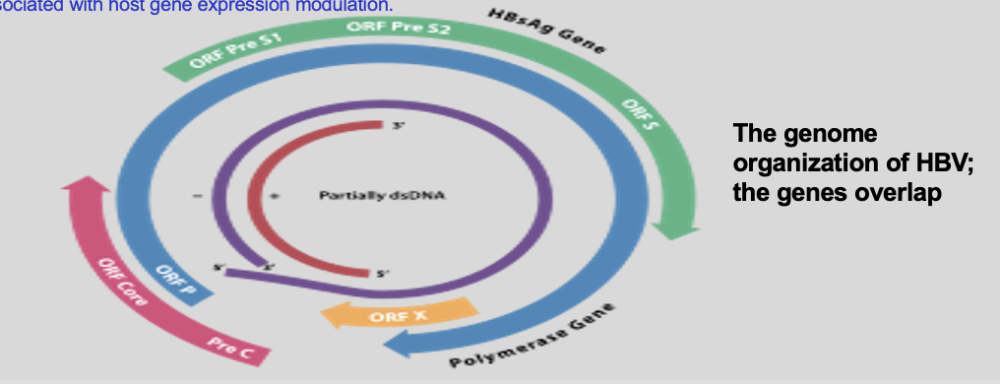
- viral DS DNA convert to covalently closed circular DNA by viral polymerase (in nucleus)
- replication involve RNA intermediate
- 4 main reading frames encoded = virus has 4
genes that encode 7 proteins
- core capsid protein C
- viral polymerase P
- surface antigens (preS1, preS2, S, X, HBeAg)